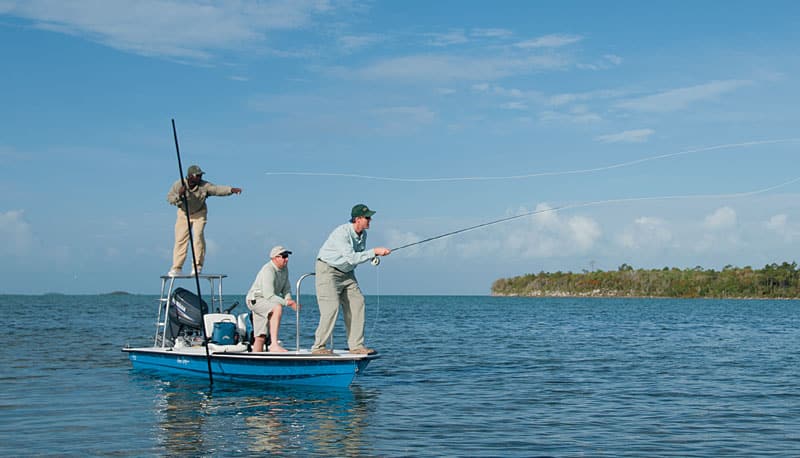
bonefish tips
Going by the moniker “gray ghosts,” bonefish live in a constant struggle to feed and avoid predation at all costs. Everything a bonefish does in life involves feeding and camouflaging itself from predators that share its habitat. Predators’ success in catching bonefish is based on adapting to and blending into the surroundings to avoid detection. To aquatic species such as sharks and barracudas, this adaptation comes naturally. However, for fly-anglers, this adaptation isn’t that simple.
Setting Out
A typical day of bonefishing often starts with meeting the guide at the dock. I have seen countless anglers try to help their guides, leaning over the skiff to push off for the day, removing bow ropes, stowing their own gear in the wrong places and breaking rods by placing them in holders incorrectly. While the intentions of the client are good, the reality is that guides are fully capable of setting off for the day, understand the best places to stow gear and know the right way to put rods in the holders. And, the truth be told — they’d probably prefer to do it themselves.
That’s why they are guides, and that’s why they are hired to do what they do. Let your guide take control of the boat and help you place your gear in the right place. Trust me, allowing the guide to complete his daily routine will enhance the fishing and put him at ease and in his element. It goes without saying that bonefish can be very tricky, so it’s important to remember that you and your guide are a team, and both your heads have got to be in the game. If the captain wants help, believe me, he will ask.
Showing Your Skills
Something else that will help in bonefishing situations is to take just a few minutes before reaching the first flat to show the guide what you’ve got as far as casting skills. Simply stand on the bow, strip off a comfortable amount of line and begin your motion. During this quick practice session, cast as far and as quickly as you can in a variety of directions. This will give your guide an idea of how he should approach spotted fish and how far you can comfortably make an accurate presentation. Taking the time to do this will place both of you on the same page before you get on a school or even a single trophy bonefish. If he says something completely different from what you think, then you have an idea of his point of view before he calls out fish direction and distance. This can make or break a trip. Communication will only increase your chances of proper presentations and catching bones.
Another aspect that is often overlooked is wearing the right gear at the right time. For example, if you aren’t wading, don’t wear wading boots on the boat. They are hot and uncomfortable topside, and more importantly, they have many objects on them that can easily catch line and ruin your presentation. If your feet need sun protection, try wearing thin socks. Bare feet are best, but thin socks will still allow you to know if you are standing on the line. Also, on most equipped guide skiffs, there is no need to wear pliers on your belt, as fly line will always find a way to attach itself to these at the wrong moment. Pliers can stay with the captain or safely in your gear bag tucked away in the skiff. The guide will most likely help with any landed fish anyway. Basically, dressing appropriately and using the right gear at the right time helps alleviate potentially stressful situations, which somehow bonefish always seem to detect.
In the Element
When it is time to get in the water and wade, you are truly entering the bonefish world. Now is when to reach in the hatch and strap on your boots. Not having proper wading boots can be a deal breaker on a bonefishing adventure. Oftentimes bonefish are found on flats strewn with sharp coral, sea urchins and other objects that can be harmful to an angler’s feet. Also, avoid bright-colored boots or tennis shoes. Try to use boots that match the color of the sand on most bonefish flats. And avoid using boots that have metal lace rings. Remember, when wading, you are a part of the delicate ecosystem too. Bonefish come to the flats to feed, and they are vulnerable to species coming on the flats to feed on them. They are on the lookout for shiny barracuda, wake-pushing sharks and even birds of prey.
Try your best to blend in, and keep in mind how the big three bonefish predators fail in catching their prey. Sharks make a lot of noise and spook fish — therefore it is important to keep quiet in your movements. Lighten your step and try to keep your feet in the water. Barracuda are highly reflective — therefore you should avoid wearing anything shiny that can catch a bonefish’s eye. Birds of prey come from the sky and pick up bonefish with their odd-colored feet — so it is a good idea to wear soft-colored shirts and avoid bright shades of clothing. Trust me, bonefish are constantly on guard. They are very smart and can easily detect any abnormality in their world from a long distance.









